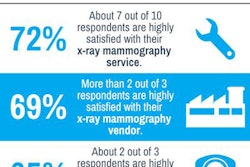Most experts agree that the one-size-fits-all strategy for breast screening has shortcomings. Breast density has been seen as a way to possibly tailor screening to women's risk factors, such as breast density, which puts women at a higher risk of developing cancer.
To that end, a team led by Dr. Sam Dumonteil examined data from 70,435 mammograms from 63,577 women in the U.K. National Health Service Breast Screening Programme, with studies acquired from 2013 to 2016. Breast density for the mammograms was calculated using commercially available software (Volpara, Volpara Solutions) and quantified using the application's Volpara density grade (VDG) calculations, which categorize density into four groups, from VDG 1 at the lowest density to VDG 4 at the highest density.
Next, the researchers divided their population into three nine-year age groups: 47 to 55, 56 to 64, and 65 to 73. The cancer detection rate was stratified by both age and VDG groups, and the Fisher's exact test was used to measure statistical significance.
Overall, the researchers found 557 cancers, for an overall cancer detection rate of 0.8%. But they found clear differences in the detection rate between age groups. Among the youngest women, those with the highest level of breast density had a higher cancer detection rate, at 0.85% for women at the VDG 4 level compared with 0.16% for women at the VDG 1 level. The difference was statistically significant (p < 0.01).
The opposite was true for women in the oldest cohort, ages 65 to 73. Among these women, those with the least dense breast tissue had a cancer detection rate of 0.99%, compared with a rate of 0.24% for women with the densest tissue. The difference was statistically significant (p < 0.04).
For women in the middle group, ages 56 to 64, there was no statistically significant difference in the cancer detection rate between the density groups, with those in the VDG 1 group recording a rate of 0.63% and those in the VDG 4 group at 0.58% (p = 0.84).
The effect of breast density on cancer detection varied by age and should be taken into account when developing different screening strategies for women, the researchers concluded.



















